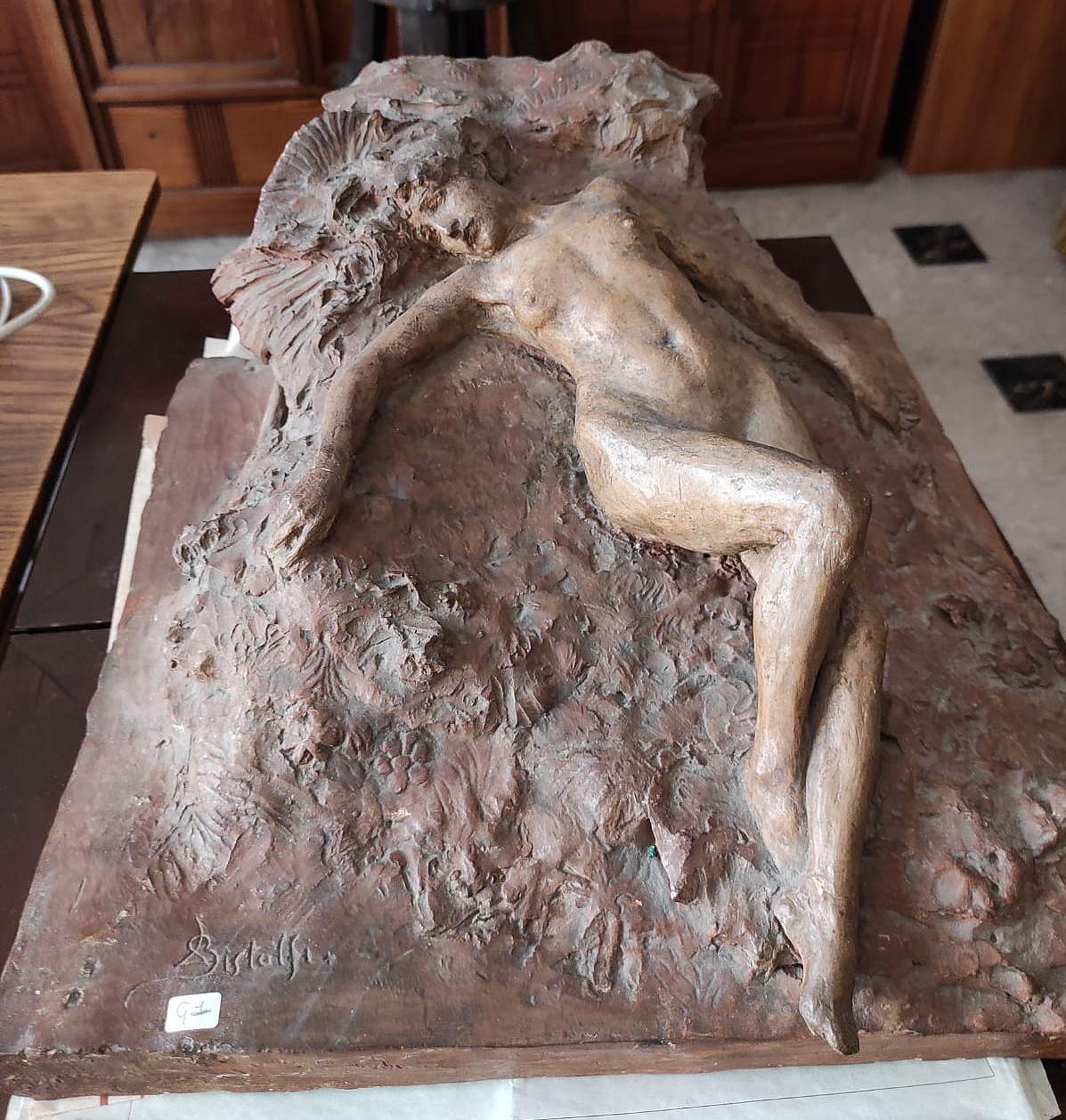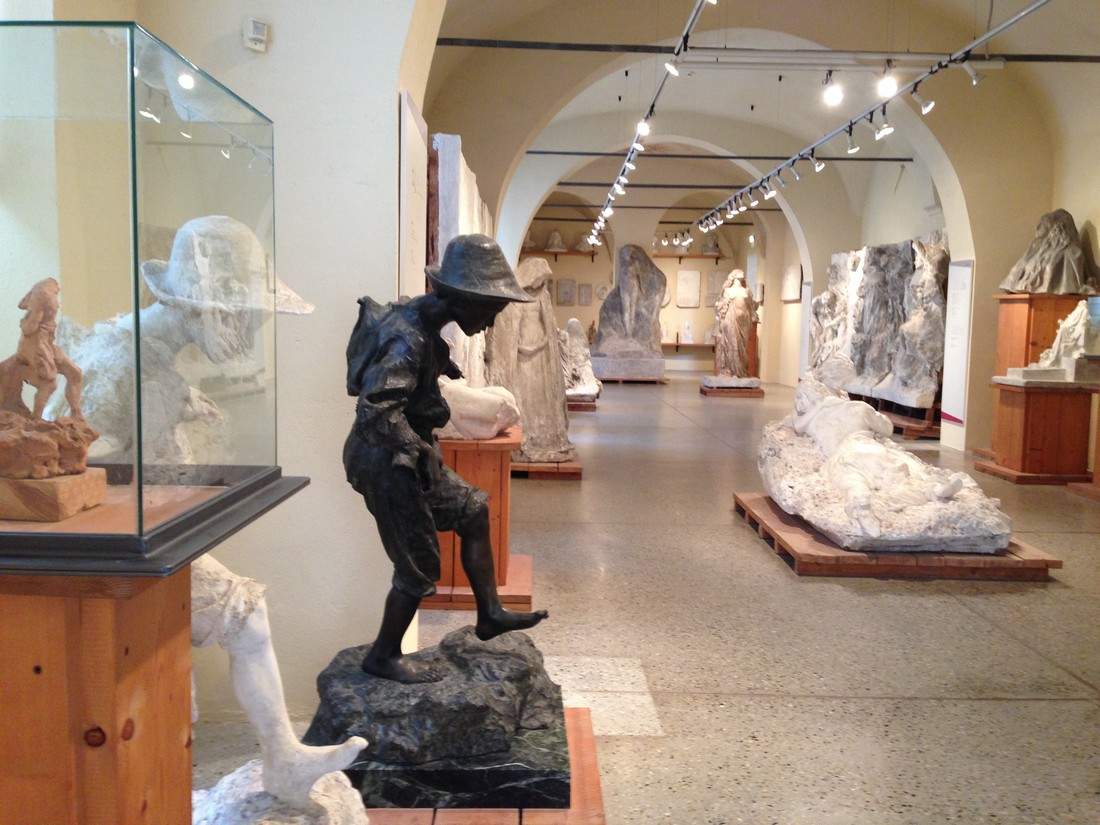The artistic legacy of one of the greatest Italian sculptors of the late 19th century, Leonardo Bistolfi (Casale Monferrato, 1859 La Loggia, 1933) becomes public: the Municipality of Casale Monferrato has in fact reached an agreement with Bistolfi’s heirs for the transfer to the Bistolfi Gipsoteca of the important artistic and documentary heritage that belonged to the artist. The agreement comes 88 years after Bistolfi’s death: an important part of his oeuvre is thus reassembled in his hometown. The dialogue had been initiated after the death of the last heir, Andrea, in June 2019, by his widow Vanda Martelli Bistolfi, who had begun discussions with the municipality for a new location of the collection, identified therefore in the gipsoteca. The official signature on the donation agreement was placed Tuesday, January 19, in Turin by Mayor Federico Riboldi and Mrs. Vanda Martelli, under the supervision of notary Marina Aceto.
Thus, to the Municipality of Casale Monferrato will come the artistic heritage of the Bistolfi family, consisting of sculptures, paintings, drawings, graphic works, notebooks, archival materials and books, all coming directly from the studio of the sculptor, who died in 1933 and whose remains are buried in the city’s monumental cemetery’s famedarium. Numerous contacts have taken place in recent months between the Municipal Administration, the Museum and Mrs. Martelli in order to reach this important goal: fundamental also was the analytical inventorying of the assets entrusted to Sandra Berresford, a lecturer, scholar and expert in the field, as well as an appreciated and undisputed connoisseur of Leonardo Bistolfi’s artistic career.
Tuesday’s, however, is only the formalization of a path that has always linked the city of Casale Monferrato, in particular the Museum, and the Bistolfi family: in fact, the very first exhibition dedicated to the sculptor dates back to 1984, an initiative that had initiated the study of the works, the publication of a catalog and a restoration campaign. This was followed in 1995 by the first donation of works of art by the will of Andrea, on the occasion of the opening of the Civic Museum, and then consolidated in 2001 with the addition of new works destined for the fifth room of the Gipsoteca. The Bistolfi couple also did not fail to be present in Casale Monferrato on various official occasions: exhibition openings, conferences, presentations.
 |
| Leonardo Bistolfi |
 |
| The Bistolfi donation |
 |
| The Bistolfi Donation |
 |
| The Bistolfi donation |
The collection that will arrive in Casale Monferrato consists of works directly produced by Leonardo Bistolfi: 20 terracottas and terracrude, 9 works in metal, 20 in plasticine, 170 plaster sculptures, one in marble, about fifty plaster medals and about forty metal coins, a very large collection of drawings of various formats enclosed in albums and folders, 50 paintings of medium and small format, 35 notebooks, miscellany and memorabilia, correspondence from and to Bistolfi, and the family archive. Added to this remarkable body of works are other materials by artists contemporary with him: sculptures, paintings, graphic works, an extensive library and a collection of period magazines. The works will then reach the Museo Civico, where the Gipsoteca is housed: here there are more than one hundred and seventy works including terracottas, drawings, plastiline, sketches and plaster models, some marbles and bronzes from the donation of the Casalese banker Camillo Venesio in 1958 and supplemented later with donations and works on deposit from the Bistolfi family.
These are materials that allow us to understand the different stages of the artistic process of Bistolfi, one of the greatest interpreters, internationally, of symbolism: from the terracotta sketch in which the sculptor fixed with immediacy the first intuition, to the subsequent plaster sketch, to the final model that concretized the final idea and constituted the actual realization of the work, before its transposition into marble and bronze. The works on display document Bistolfi’s articulated artistic journey: from the beginnings that link him to the contemporary Lombard experiences of the Scapigliatura(Gli amanti, 1883), interspersed with small groups of verista taste (such as Il boaro de 1885) to the elaboration of his own language, in which figure and symbol will give life to a highly personal poetics that will be reflected in numerous private and public commissions, many of them related to funerary and celebratory sculpture. It would then be The Sphinx (1890) for the Pansa funerary monument in Cuneo that would consecrate him as a Symbolist sculptor, which would be followed by relevant works such as Grief Comforted by Memories (1898) or The Funeral of a Virgin (1899) or even Resurrection (1902) and The Cross (1899). But Bistolfi’s celebratory monuments, made for Giovanni Segantini (1899), Giuseppe Zanardelli (1908), Cesare Lombroso (1921), Giosuè Carducci (1908-1928) and those for Giuseppe Garibaldi (1908 and 1928), are equally well known, to which are added numerous portraits and commemorative plaques.
Receipt of the new materials in Casale Monferrato, which will take place in batches with firms specializing in the transportation of works of art and under the supervision of museum staff, involves initial placement in storage rooms. The state of preservation and suitable methods for proper conservation, as well as maintenance interventions, will be checked through the collaboration of the competent Superintendency. A high-resolution photographic campaign will then be carried out and the paper materials will be digitized, which will be used not only for the Museum’s internal use, but also made available through online consultation, with controlled access modes. The Gipsoteca therefore aspires to be not only an exhibition hall, but also a place of reference for studies on Leonardo Bistolfi, to whom people will be able to turn for consultation of the sculptor’s archives. A digital project of geolocalization of the artist’s works located on the Italian territory is also in the works: this operation involves museums, cemeteries, historic buildings, public and private entities from which the Museum has asked for collaboration in order to create an electronic mapping, which will be made available on the website. A tourist tool, but also a tool for in-depth study, which will make it possible to put the realized monument and the plaster model or preparatory sketch or drawing kept in the Museum in dialogue.
 |
| The Gipsoteca Leonardo Bistolfi in Casale Monferrato |
 |
| The Leonardo Bistolfi Plaster Collection in Casale Monferrato |
 |
| The Leonardo Bistolfi Plaster Casts Gallery of Casale Monferrato |
While waiting to implement the plans for the actual enhancement of the Gipsoteca, which in addition to providing for a partial renovation of the current premises do not exclude the creation of a real dedicated museum, we are considering ways to make the donated works immediately available to the public: partial or rotating exhibitions, the creation of enhancement events, the inclusion of some works in the exhibition path of the Gipsoteca or the establishment of an open deposit, as well as the complete availability of the collection to visitors through multimedia tools.
“The administration is grateful and thankful to Mrs. Bistolfi for the trust she has placed in the city of Casale Monferrato,” says Mayor Federico Riboldi, “and in particular to the Civic Museum, and for opening the doors of her home, which have so far preserved with such care and devotion every bit of evidence from the sculptor’s studio.”
“We consider this donation, which implements and completes the Museum’s collection,” says Deputy Mayor Emanuele Capra, “of enormous importance for our Administration, which has among its goals that of giving Bistolfi the right appreciation so that it becomes one of the main reasons for attracting cultural tourism.”
“With this donation,” explains Culture Councillor Gigliola Fracchia, “our Gipsoteca and our city will be able to become the hub for studies and in-depth studies on the artistic life of one of the most important Symbolist sculptors in Italy, capable with his works to embellish and enrich squares, theaters, palaces and cemeteries all over the World.”
For the curator of the Museo Civico Gipsoteca Leonardo Bistolfi, Alessandra Montanera, this is “an extraordinary opportunity. The materials that will be conferred to the Museum of Casale Monferrato represent a unique cultural inheritance, which will make it possible to bring together in a single place precious objects that will allow us to delve into the artistic and human journey of this great artist, contributing to the enhancement of his figure. Lacquisition, transfer and the first operations aimed at the protection and preservation of this precious cultural deposit, will be planned to make it as soon as possible accessible and usable to all.”
 |
| Casale Monferrato acquires an important nucleus of works by Leonardo Bistolfi |
Warning: the translation into English of the original Italian article was created using automatic tools. We undertake to review all articles, but we do not guarantee the total absence of inaccuracies in the translation due to the program. You can find the original by clicking on the ITA button. If you find any mistake,please contact us.